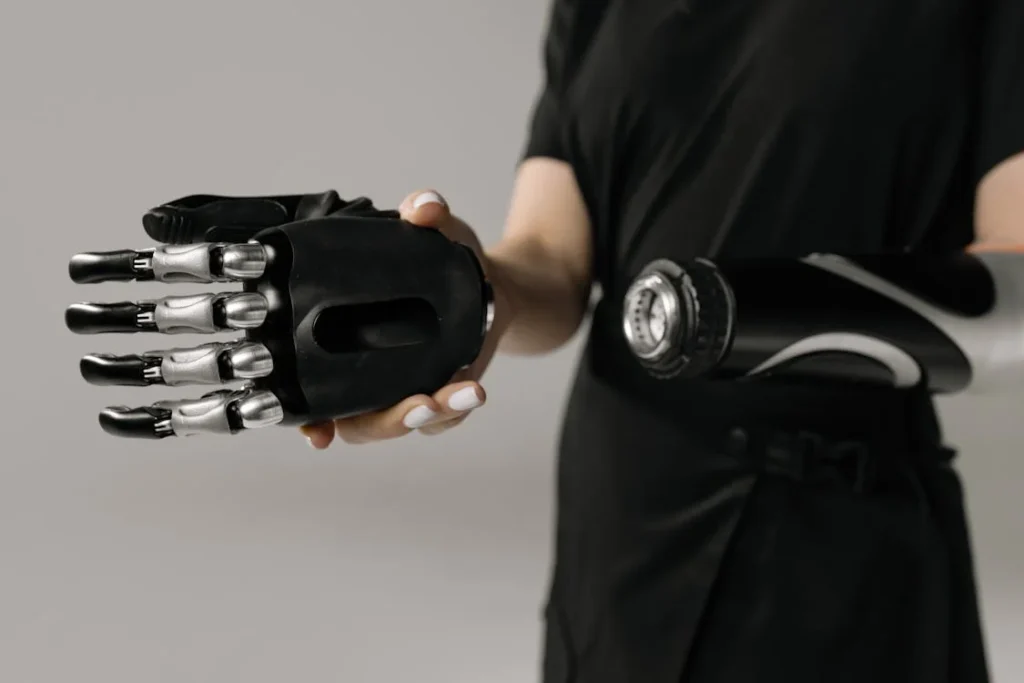Imagine being able to move an artificial hand just by thinking about it. That’s exactly what myoelectric prosthetics make possible. These advanced prosthetic hands respond to tiny electrical signals in the muscles, allowing people with limb loss to regain natural movement. Unlike traditional prosthetics that rely on body harnesses or mechanical control, myoelectric hands provide a seamless, intuitive experience.
For someone who has lost a hand, daily tasks like picking up a cup, tying shoelaces, or even shaking hands can feel impossible. But with myoelectric technology, these actions become natural again. The real magic lies in how these prosthetics read muscle signals and translate them into movement—just like a real hand.
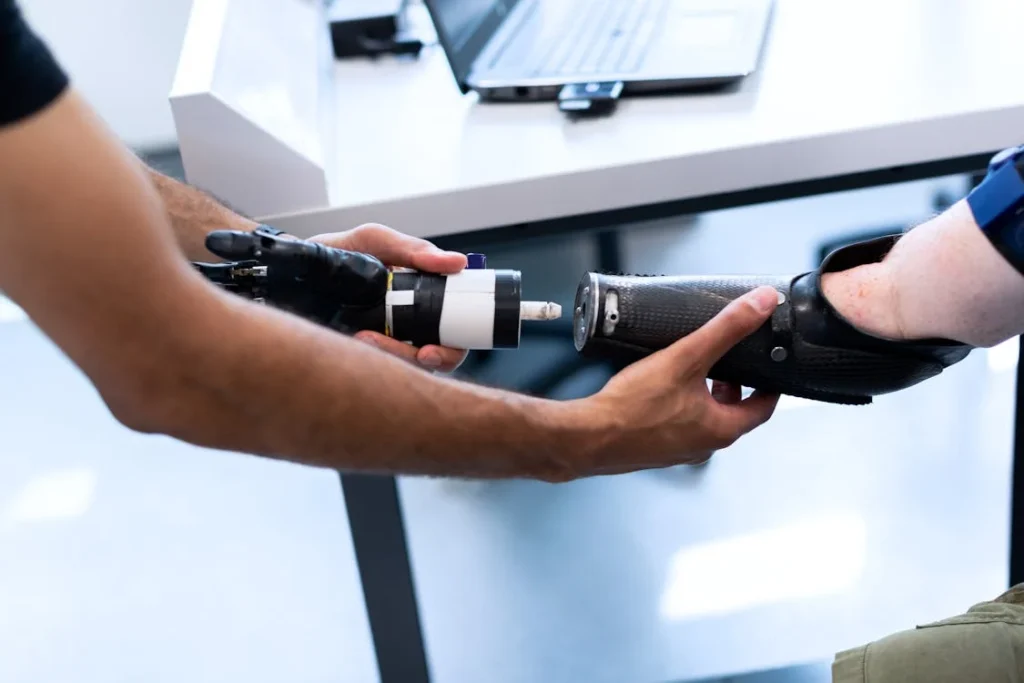
Understanding How Myoelectric Prosthetics Work
Myoelectric prosthetics are designed to function like real hands by responding to the user’s muscle movements. Instead of relying on cables or harnesses like traditional prosthetics, these advanced devices pick up electrical signals directly from the muscles.
These signals, known as electromyographic (EMG) signals, are generated when a person attempts to move their missing limb.
The Role of Muscle Signals
Every time you move your hand, your brain sends electrical signals through nerves to activate your muscles.
Even if a hand is missing, the muscles in the residual limb still receive these signals. Myoelectric prosthetics use electrodes placed on the skin to detect these signals.
These electrodes act as sensors, picking up the electrical impulses and sending them to the prosthetic’s control system. The stronger the muscle contraction, the stronger the signal, allowing for precise control of movements.
For example, if a person wants to close their prosthetic hand, they contract a specific muscle in their forearm. The electrodes detect this signal and instruct the prosthetic fingers to close. If they relax the muscle, the hand opens.
This simple but effective process allows users to perform a wide range of actions, from gripping delicate objects like a piece of paper to holding something heavy like a grocery bag.
From Signal to Movement: How Control Systems Work
The real intelligence behind myoelectric prosthetics lies in their control system. Once the electrodes detect the EMG signals, these signals are processed by a microprocessor inside the prosthetic hand.
This processor acts like a small computer, interpreting the signals and converting them into specific hand movements. Modern myoelectric prosthetics use machine learning and artificial intelligence to improve accuracy.
Over time, the system learns how the user moves and adapts to their unique muscle patterns. This means that the prosthetic hand can become more intuitive, responding more naturally to the user’s intentions.
Some high-tech prosthetics even allow for multi-grip patterns, meaning the user can switch between different types of grips depending on the task.
For example, they can use a pinch grip for picking up small objects, a power grip for carrying larger items, or a precision grip for holding a pen. These variations make it possible to perform daily tasks with greater ease and confidence.
Powering the Prosthetic: The Battery and Motors
Myoelectric prosthetic hands require an internal power source to function. Most devices are powered by rechargeable lithium-ion batteries, which provide enough energy for a full day of use.
The motors inside the prosthetic hand are responsible for moving the fingers and thumb. These motors work smoothly and quietly, ensuring that the prosthetic functions naturally. The placement of these motors allows for independent finger movement in more advanced models.
This means users can control each finger separately rather than just opening and closing the entire hand at once. This level of control makes complex tasks, such as typing on a keyboard or using a smartphone, much easier.
Why Myoelectric Prosthetics Feel Natural
The biggest advantage of myoelectric prosthetics is how naturally they mimic real hand movements. Because they respond to muscle signals, users don’t have to rely on uncomfortable straps or exaggerated body movements to control them.
The experience is closer to how a real hand functions, making the transition smoother for those adapting to a prosthetic limb. In addition to movement, some advanced myoelectric prosthetics also provide sensory feedback.
This means they can send signals back to the user, simulating a sense of touch. While this technology is still developing, early models have already shown promising results, helping users feel more connected to their prosthetic hand.
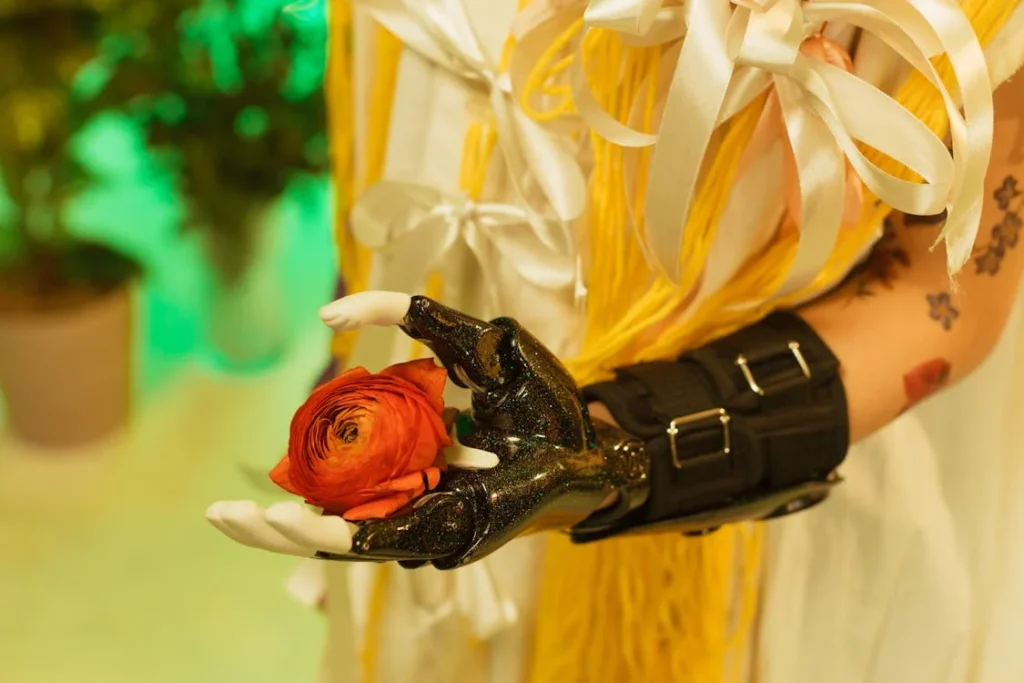
How Myoelectric Prosthetics Mimic Natural Hand Movements
Myoelectric prosthetics are designed to move as naturally as possible, allowing users to perform everyday tasks with ease. This technology is a breakthrough for people with limb loss, as it enables them to control an artificial hand using their own muscle signals.
But how exactly do these prosthetics replicate the complex and delicate movements of a real human hand?
Decoding Hand Movements: The Complexity of Human Motion
The human hand is one of the most intricate parts of the body. It has 27 bones, numerous muscles, and an advanced nerve network that allows for fine motor control.
Simple tasks like picking up a cup or tying a shoelace require precise coordination of multiple fingers, wrist movement, and varying levels of grip strength.
For myoelectric prosthetics to successfully mimic these movements, they must translate muscle signals into actions that feel intuitive. This is achieved through a combination of sensors, artificial intelligence, and mechanical engineering.
Each component plays a role in ensuring that the prosthetic responds naturally, much like a biological hand would.
How Sensors and Electrodes Replicate Natural Control
Myoelectric prosthetics rely on surface electrodes that detect electrical signals from the muscles. These electrodes are placed on the residual limb, typically on the forearm, where key muscle groups still function.
When a user attempts to move their missing hand, the muscles in their forearm generate electrical activity. The prosthetic captures these signals and converts them into movement.
Unlike mechanical prosthetics, which require physical force or harnesses to operate, myoelectric hands respond instantly to these muscle signals. This allows users to control their prosthetic with minimal effort, making movements feel smooth and natural.
Artificial Intelligence: Teaching the Prosthetic to Move Like a Real Hand
One of the key advancements in myoelectric prosthetics is the integration of artificial intelligence (AI). In traditional prosthetics, users must learn how to manipulate the device through repeated practice.
With AI-powered myoelectric hands, the prosthetic learns from the user instead. Through machine learning algorithms, the prosthetic can recognize subtle muscle patterns and adapt to the user’s movements over time.
This means that as the user becomes more comfortable with the device, the prosthetic becomes more intuitive, reducing the need for conscious effort. For example, if a user frequently picks up a spoon, the AI system can recognize the muscle patterns associated with this action.
Over time, the prosthetic will improve its response, making the movement feel more natural. This type of adaptive control allows for a personalized experience, tailored to the user’s unique muscle activity.
Advanced Grip Patterns: Adapting to Different Tasks
A major challenge in prosthetics is recreating the wide variety of grips that a human hand can perform. Unlike traditional prosthetics that offer only basic opening and closing functions, modern myoelectric hands can switch between multiple grip patterns.
Some advanced myoelectric prosthetics allow users to perform different grips such as a power grip for holding heavy objects, a precision grip for delicate tasks like picking up a coin, and a tripod grip for holding a pen. This versatility gives users more control over their prosthetic, allowing them to perform daily tasks with greater confidence.
Finger Dexterity and Individual Control
Early prosthetic hands had limited movement, with all fingers operating as a single unit. However, modern myoelectric prosthetics have motors in each finger, enabling independent movement.
This feature allows for more precise actions, such as typing on a keyboard, playing a musical instrument, or using a smartphone. By enabling users to control each finger separately, myoelectric prosthetics closely replicate the dexterity of a human hand.
This enhances functionality and improves the overall user experience, making artificial hands feel more like an extension of the body rather than an external device.
Restoring Natural Motion Through Wrist and Elbow Integration
In addition to hand function, myoelectric prosthetics are increasingly incorporating wrist and elbow movement for a more natural range of motion. Some models include motorized wrists that rotate, allowing users to position their hand more naturally while performing tasks.
This is particularly useful for actions like turning a doorknob or pouring a drink. By integrating wrist and elbow control, myoelectric prosthetics can better mimic the way a real arm moves, reducing strain on the shoulder and improving overall comfort.
This makes daily activities feel more intuitive, especially for users who rely on their prosthetic for extended periods.
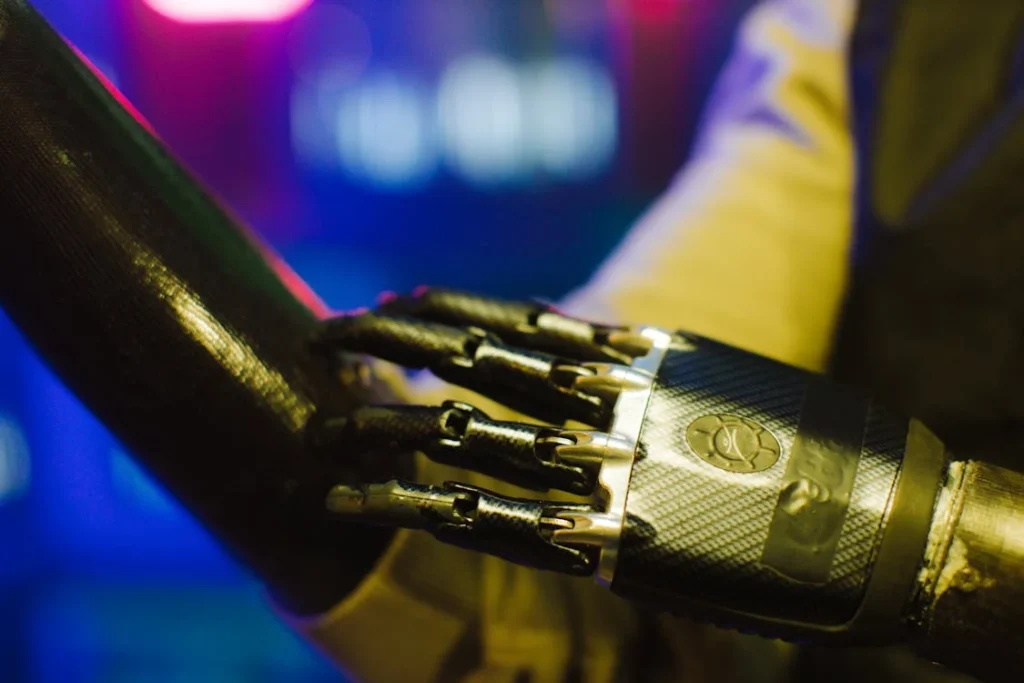
Enhancing User Experience: Comfort, Adaptation, and Sensory Feedback
Myoelectric prosthetics do more than just restore movement—they aim to make the experience as natural and comfortable as possible. The more a prosthetic feels like a natural extension of the body, the easier it is for users to integrate it into their daily lives.
Comfort, ease of use, and even sensory feedback play a crucial role in making myoelectric prosthetics feel more lifelike.
Ensuring a Comfortable Fit for Long-Term Use
One of the biggest challenges with any prosthetic is ensuring that it fits well and remains comfortable throughout the day. Since myoelectric prosthetics rely on electrodes placed on the skin, they must maintain good contact with the residual limb without causing discomfort.
Modern prosthetic sockets are designed to distribute pressure evenly, preventing pain and irritation. Custom-molded sockets, often created with 3D scanning and printing technology, ensure a snug but comfortable fit.
Some prosthetics even feature soft inner linings that reduce friction and allow for better breathability.
A well-fitting prosthetic not only improves comfort but also enhances control. If the socket is too loose or shifts during use, the electrodes may not properly detect muscle signals, leading to unreliable performance.
Proper fitment ensures that the prosthetic responds accurately to the user’s movements, making it feel more natural.
Reducing Learning Curves with Intuitive Controls
Adapting to a myoelectric prosthetic takes time, but modern advancements have made the process much easier. Traditional prosthetics required users to learn complex mechanical movements to operate them.
In contrast, myoelectric hands work by simply contracting muscles, making the learning curve much smoother. Many devices come with training programs that help users develop muscle control.
These programs often include visual feedback, such as on-screen muscle signal monitoring, to help users understand how their movements translate into prosthetic motion. With regular practice, users can gain full control of their prosthetic, making movements feel more natural over time.
The Future of Sensory Feedback: Restoring the Sense of Touch
While myoelectric prosthetics excel at mimicking movement, they currently lack the full sensory experience of a natural hand. However, new research is making it possible to restore a sense of touch through advanced feedback systems.
Some prosthetic hands now include pressure sensors that send signals to the user, simulating touch. These sensors can provide feedback on grip strength, preventing users from crushing fragile objects.
Some experimental models even connect directly to the nervous system, allowing for more realistic sensory experiences. By integrating touch feedback, myoelectric prosthetics can help users feel more connected to their artificial limb.
This breakthrough is expected to improve confidence and make it easier for users to perform delicate tasks that require a sense of pressure and resistance.
How Gamified Rehabilitation Makes Adaptation Easier
At Robobionics, we understand that adapting to a prosthetic should be an engaging and empowering experience. That’s why we emphasize gamified rehabilitation—interactive training programs that make learning to use a prosthetic fun and effective.
By incorporating video games and virtual reality simulations, users can practice real-life movements in a controlled environment. These programs encourage muscle training, improve reaction times, and build confidence.
Gamified rehabilitation helps users see their prosthetic not as a foreign device, but as a natural extension of their body.
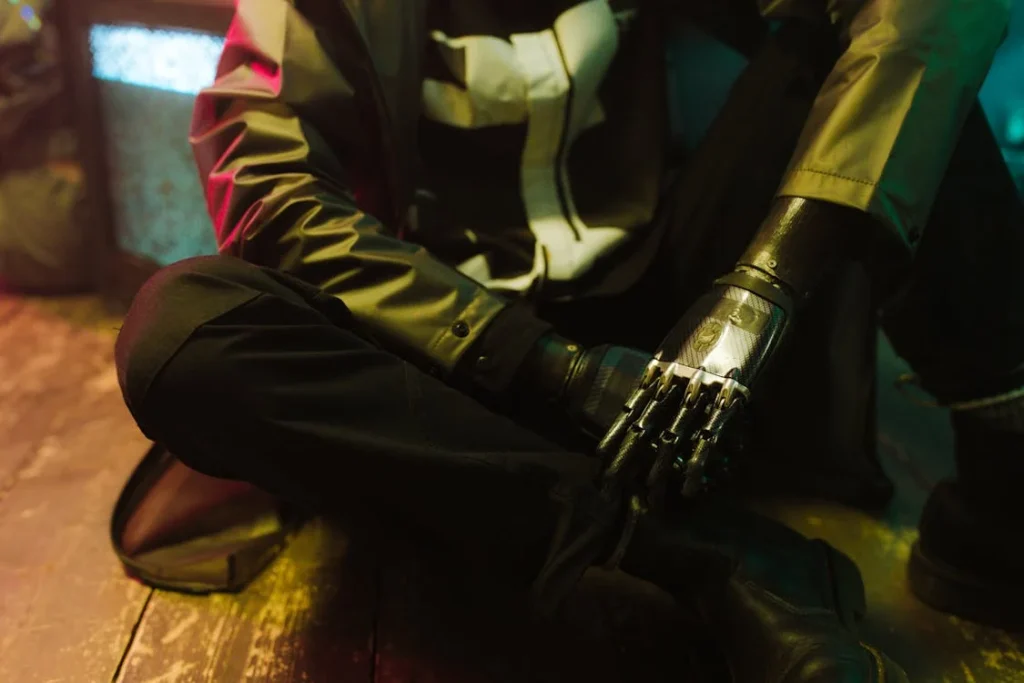
Real-World Impact: How Myoelectric Prosthetics Change Lives
Myoelectric prosthetics do more than restore movement—they bring back independence, confidence, and the ability to perform everyday tasks that many people take for granted. The impact of these advanced prosthetic hands is deeply personal, helping individuals regain control over their lives after limb loss.
Whether it’s holding a child’s hand, preparing a meal, or returning to work, the ability to move naturally again can be life-changing.
Regaining Independence in Daily Life
One of the biggest advantages of myoelectric prosthetics is that they allow users to perform daily tasks without constant adjustments or mechanical effort. Unlike traditional prosthetics, which often require body-powered mechanisms or extensive training, myoelectric hands function by responding to natural muscle movements.
This means that simple yet important activities—like buttoning a shirt, pouring a drink, or opening a door—become possible again. Tasks that once required assistance from others can now be done independently, restoring a sense of self-sufficiency.
For many users, this newfound independence leads to increased confidence. Instead of focusing on the limitations of limb loss, they can focus on what they are capable of doing with their prosthetic hand.
Over time, the prosthetic becomes less of a device and more of a natural extension of the body.
Returning to Work and Hobbies
Limb loss can disrupt careers and hobbies, but myoelectric prosthetics are helping people get back to doing what they love. Many jobs require fine motor skills, grip strength, or multitasking with both hands.
Myoelectric hands provide the dexterity needed for office work, manual labor, and even artistic professions. For example, a graphic designer who loses a hand may struggle with using a stylus or keyboard.
With a multi-grip myoelectric prosthetic, they can regain the ability to switch between grips for different tasks, making it possible to continue working. Similarly, a chef can use their prosthetic to hold kitchen tools, mix ingredients, and perform detailed work with ease.
Beyond work, hobbies such as playing musical instruments, gardening, or sports become possible again. Some myoelectric prosthetic users have even learned to play the piano, ride bicycles, or participate in athletic competitions.
With advancements in prosthetic design, users can continue doing what brings them joy without limitations.
Emotional and Psychological Benefits
The impact of myoelectric prosthetics isn’t just physical—it’s deeply emotional. Losing a limb can be a difficult experience, often leading to frustration, self-doubt, or even depression.
However, the ability to regain movement and independence can significantly improve mental well-being. Many users report feeling more confident in social situations because they no longer have to worry about relying on others for help.
The natural appearance and movement of myoelectric hands also help users feel more comfortable in public, reducing self-consciousness.
Prosthetic technology is also fostering a strong sense of community. Organizations and support groups provide spaces for individuals with limb loss to share their experiences, offer advice, and celebrate progress together.
By connecting with others on similar journeys, users feel less alone and more empowered to embrace their prosthetic as a part of themselves.
Why Choosing the Right Prosthetic Matters
Not all prosthetics are the same, and choosing the right one can make all the difference.
At Robobionics, we specialize in designing lightweight, ergonomic, and high-performing prosthetic solutions tailored to each individual’s needs. Our flagship product, Grippy™, is a myoelectric prosthetic hand designed to provide intuitive control, a comfortable fit, and a natural look.
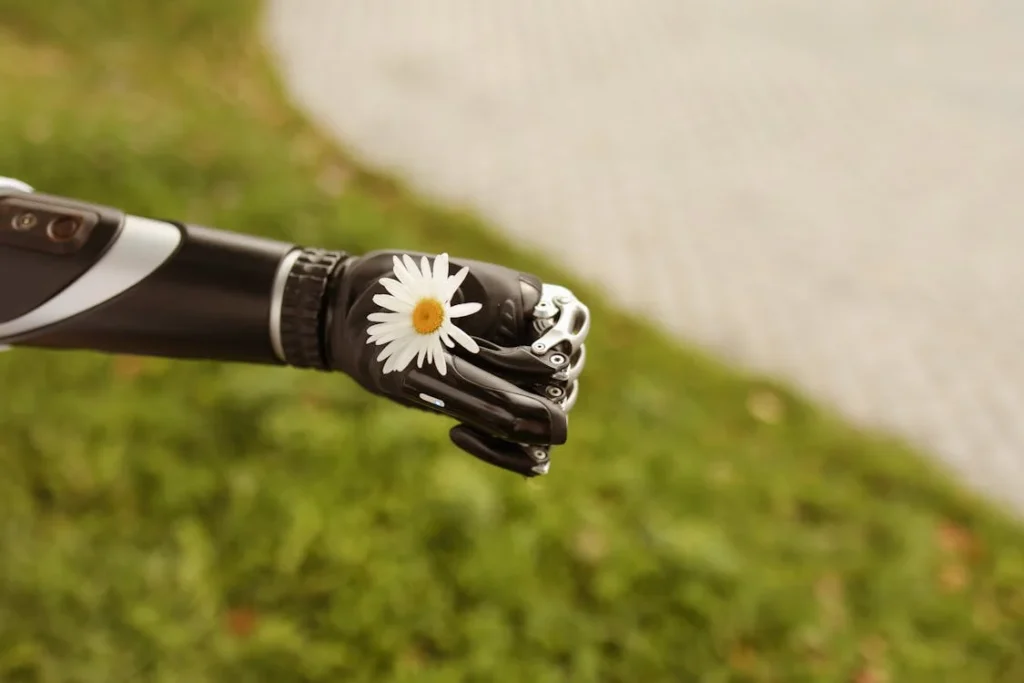
The Future of Myoelectric Prosthetics: Advancements and Innovations
Myoelectric prosthetics have already transformed the lives of thousands, but the technology is still evolving. Researchers and engineers are continuously working on new ways to make prosthetic hands even more natural, intuitive, and responsive.
The future holds exciting advancements in areas like artificial intelligence, sensory feedback, lightweight materials, and even mind-controlled prosthetics.
Next-Generation AI and Machine Learning
Today’s myoelectric hands use artificial intelligence (AI) to interpret muscle signals, but the future promises even smarter prosthetics. With advanced machine learning algorithms, future prosthetic hands will become even better at adapting to users’ movements.
AI-driven prosthetics will be able to learn a user’s unique muscle patterns faster, reducing the training period and making movement more fluid and effortless. In addition to improving grip control, AI-powered prosthetics could one day predict user intentions based on muscle memory.
This means that instead of waiting for a signal to move, the prosthetic could anticipate a user’s action and respond instantly. Such a breakthrough would make prosthetic hands feel even more natural, almost as if they were an extension of the body itself.
The Rise of Sensory Feedback: Feeling Through a Prosthetic
One of the biggest limitations of current prosthetics is the lack of sensation. While myoelectric hands can move, they do not provide users with a sense of touch. However, scientists are making rapid progress in developing prosthetics that can send sensory feedback to the brain.
New technologies are being tested that allow prosthetic hands to send electrical signals to the nerves in the residual limb.
These signals mimic the feeling of touch, pressure, and even temperature. Some experimental prosthetic hands have already enabled users to “feel” objects they are holding, which dramatically improves control and precision.
With further advancements, future myoelectric prosthetics will not only move like a natural hand but also allow users to experience textures and sensations, restoring a crucial part of human touch.
Lighter, More Durable Materials for Enhanced Comfort
Comfort is a crucial factor for prosthetic users, and researchers are developing new materials to make myoelectric hands even more lightweight and durable.
Currently, many prosthetics are made from plastics and metals, but future models may incorporate high-tech materials like carbon fiber composites and smart polymers that can change shape based on muscle activity.
These advancements will reduce fatigue, improve wearability, and make prosthetics feel even more like a natural part of the body.
More flexible and breathable socket designs are also in development to ensure a more comfortable fit, preventing skin irritation and pressure sores.
Mind-Controlled Prosthetics: The Ultimate Breakthrough
Perhaps the most exciting development in prosthetic technology is the possibility of brain-controlled prosthetics. Scientists are working on neural interfaces that connect directly to the brain, allowing users to control their prosthetic hand just by thinking about a movement—without the need for muscle signals.
Early experiments have already shown success, with some patients able to move robotic arms using only their thoughts. As this technology advances, we could see a future where myoelectric prosthetics are replaced by fully neural-controlled limbs, offering movement that is indistinguishable from a biological hand.
Expanding Accessibility: Making Myoelectric Prosthetics Affordable
While myoelectric prosthetics offer incredible benefits, cost remains a major barrier for many people.
High-end bionic hands can be expensive, making them inaccessible to those who need them most. However, companies like Robobionics are working to change that. By using 3D printing and local manufacturing, we have developed Grippy™, an affordable and high-quality myoelectric prosthetic designed for Indian users.
Unlike imported prosthetics, which are costly and difficult to repair, Grippy™ is designed for easy maintenance and long-term durability, making it a practical solution for individuals seeking an advanced yet affordable prosthetic.

The Psychological Adaptation to Myoelectric Prosthetics
Adjusting to a myoelectric prosthetic is not just about learning how to use it—it’s also a mental and emotional journey.
Losing a limb can be a life-altering experience, and while a prosthetic restores function, adapting to it takes patience, resilience, and the right support system.
Understanding the psychological aspects of prosthetic use is just as important as understanding the technology itself.
Overcoming the Initial Adjustment Phase
The first time someone wears a myoelectric prosthetic, it can feel unfamiliar. Unlike a biological hand that moves effortlessly, a prosthetic requires conscious effort, muscle training, and practice.
Many new users experience a mix of emotions—excitement about regaining movement, frustration when learning new motor patterns, and sometimes even doubt about whether the device will truly feel like a part of them. This adjustment period is completely normal. Just as the brain adapts to using a new tool, it also adjusts to controlling a prosthetic.
Over time, movements become more intuitive, and the user develops muscle memory, making daily activities feel increasingly natural. The key to a smooth transition is regular practice, patience, and celebrating small victories along the way.
Building Confidence Through Rehabilitation
Confidence plays a huge role in how well someone adapts to a prosthetic. Many users initially hesitate to use their prosthetic in public, worried about how others might react.
Some fear that they won’t be able to perform tasks as efficiently as they did before limb loss. This is where structured rehabilitation programs and real-world practice make a difference.
Myoelectric rehabilitation isn’t just about building strength—it’s about rebuilding confidence. Training exercises help users develop fine motor control, while real-world practice, such as using the prosthetic to cook, write, or drive, reinforces the belief that they can regain independence.
Many rehabilitation centers also incorporate peer support, allowing users to connect with others who have successfully adapted to prosthetic life. Seeing others thrive with their prosthetic can be a powerful motivator.
The Brain’s Ability to Accept a Prosthetic as Part of the Body
One of the most fascinating aspects of myoelectric prosthetics is how the brain can perceive them as a natural extension of the body. Studies in neuroplasticity—the brain’s ability to reorganize and adapt—show that with consistent use, the brain starts treating a prosthetic limb as if it were a real hand.
This phenomenon, known as “embodiment,” is what allows users to control their prosthetic without consciously thinking about every movement. The more a person uses their prosthetic in daily life, the more their brain integrates it into their sense of self.
Some users even report feeling as though their prosthetic is part of them, rather than a separate tool. Advancements in sensory feedback technology are further strengthening this connection.
By allowing users to feel touch and pressure through their prosthetic, future prosthetics will deepen the brain’s ability to integrate the artificial limb into its body map.
The Emotional Journey of Acceptance
Adapting to a prosthetic isn’t just about functionality—it’s about self-acceptance. Losing a limb can change how a person sees themselves, and it takes time to rebuild self-image and confidence.
Some users go through emotional ups and downs, questioning whether they will ever feel “whole” again. However, many prosthetic users find that, over time, their focus shifts from what they have lost to what they have gained.
Regaining mobility, independence, and the ability to engage in activities they love leads to a renewed sense of purpose. The more they experience success with their prosthetic, the more they embrace it as part of their identity.
How Support Systems Influence Adaptation
The journey of adapting to a prosthetic is much easier with the right support system. Family, friends, and rehabilitation specialists play a crucial role in helping users build confidence.
Encouragement, patience, and celebrating progress—no matter how small—make a huge difference in helping someone feel empowered. Support groups and online communities also provide a space for users to share their experiences, ask questions, and learn from others who have walked the same path.
Connecting with people who understand the challenges and victories of prosthetic adaptation can be incredibly reassuring.
Moving Forward with Confidence
A myoelectric prosthetic is more than just a tool—it’s a gateway to a more independent life. While the physical adjustment is important, the emotional and psychological adaptation is equally crucial.
By embracing the learning process, seeking support, and allowing time for adjustment, users can build confidence and experience the full benefits of their prosthetic.
At Robobionics, we believe that no one should feel alone in this journey. Our team provides not only high-quality prosthetic solutions like Grippy™, but also ongoing support to ensure that every user adapts with confidence.
If you or a loved one are considering a myoelectric prosthetic, reach out to us today for guidance, a free demo, and expert support in your transition to a more independent life.
Conclusion
Myoelectric prosthetics are transforming lives by restoring natural hand movement, independence, and confidence. Unlike traditional prosthetics, they use muscle signals to create intuitive, effortless control, allowing users to perform daily tasks with precision. Advancements in AI, sensory feedback, and ergonomic design are making these prosthetics even more lifelike, improving both functionality and comfort.
Beyond the technology, the journey to adapting a myoelectric prosthetic is deeply personal. It requires patience, training, and emotional adjustment, but with the right support, users can regain not just mobility, but a renewed sense of self. The brain’s ability to integrate a prosthetic as part of the body proves that these devices are more than mechanical tools—they are extensions of human capability.
At Robobionics, we are committed to providing cutting-edge, affordable prosthetic solutions like Grippy™, designed to help individuals regain control over their lives. If you or a loved one is considering a myoelectric prosthetic, book a free demo today and take the first step toward a more independent future.



